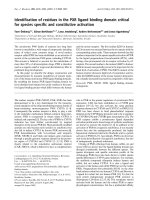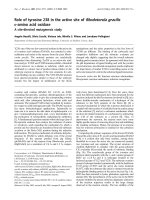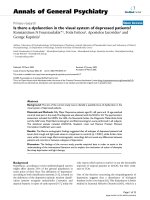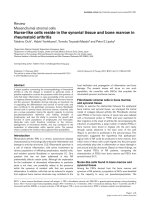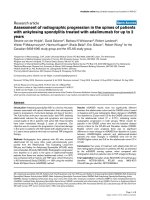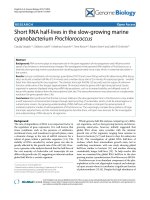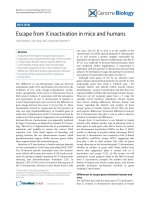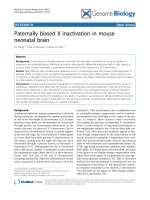Báo cáo y học: " Unfashionable crop species flourish in the 21st century" potx
Bạn đang xem bản rút gọn của tài liệu. Xem và tải ngay bản đầy đủ của tài liệu tại đây (96.22 KB, 5 trang )
Genome Biology 2004, 5:233
comment
reviews
reports deposited research
interactions
information
refereed research
Minireview
Unfashionable crop species flourish in the 21st century
Wayne Powell* and Peter Langridge
†
Addresses: *Scottish Crop Research Institute, Invergowrie, Dundee DD2 5DA, UK.
†
The Australian Centre for Plant Functional Genomics,
School of Agriculture and Wine, Waite Campus, University of Adelaide, SA 5064, Australia.
Correspondence: Wayne Powell. E-mail:
Abstract
Genome-level studies are contributing to a major renaissance in crop science. In wheat, there are
now more than 500,000 expressed sequence tags, and these are being used in conjunction with
specially designed deletion stocks to unravel patterns of genome evolution, recombination and
polyploid genome behavior.
Published: 14 June 2004
Genome Biology 2004, 5:233
The electronic version of this article is the complete one and can be
found online at />© 2004 BioMed Central Ltd
The genomic era was founded on the study of a limited
number of model organisms [1] that were chosen for their
small genome size and experimental tractability. The use of
model organisms can be powerful because a community of
scientists can work collectively on a single organism, but it
also encourages a reductionist approach. Intriguingly, the
study of diversity and organism complexity is now gaining
more prominence, often at the expense of research on
model organisms. The mapping of a large number of wheat
expressed sequence tags (ESTs) [2], physical mapping of
the wheat genome [3], studies of synteny between related
parts of the wheat genome [4,5] and between wheat and
other cereals [6], and studies of the organization of
sequence polymorphism into haplotypes [7] are big steps
forward. These developments in crop genomics vividly
illustrate how, although model organisms provide good
starting points, their significance may decline as accessibil-
ity to genome technologies improves and the social and
biological relevance of crop science to the public continues
to gain prominence.
The complex wheat genome
Before the emergence of molecular biology, crop plants such
as bread wheat (Triticum aestivum L.) were considered to be
good models for cytogenetic investigations and research into
polyploidy. Wheat has one of the largest and most complex
genomes known: it is an allopolyploid, containing three
different ancestral genomes (designated A, B and D), each of
which contains seven pairs of homologous chromosomes.
The number of chromosomes in the diploid genome (2n) is
therefore 42; this number is also referred to as 6x, as each of
the six ancestral genomes has seven chromosomes. The
homologous chromosomes and genes in different ancestral
genomes are referred to as ‘homoeologous’. Although the
ancestral genomes are very similar in gene content and gene
order, chromosome pairing at meiosis is under genetic
control and is restricted to homologous chromosomes. This
results in disomic inheritance, as if there were only two sets
of 21 chromosomes, which greatly simplifies the pattern and
interpretation of genetic segregation data. The size of the
wheat genome - 16,000 megabases, approximately three
times the size of the human genome - was initially viewed as
an impediment to genomic research, and most attention in
plants was focused on the small genomes of model plants
such as Arabidopsis and the smaller-genome crop plant rice.
One advantage of polyploidy, however, is that it provides a
huge capacity for ‘buffering’ mutations, as homoeologous
genes can make up for the loss of any deleted genes. This has
allowed the creation of an unparalleled array of aneuploid
stocks that have been used as a resource to locate genes con-
trolling agronomic and biochemical traits and also to find
genes responsible for chromosome pairing. The work of
coordinated, global genomic initiatives is dramatically
changing the knowledge base for wheat research, and is
leading to a renaissance in crop science. This is particularly
true in studies of the fascinating relationship between
recombination, synteny and genome evolution and of the
regulation of gene expression in polyploid organisms.
Recombination and genome evolution
The significance of polyploidy as a basis for chromosome
engineering (using aneuploid stocks) has long been recog-
nized, but the use of aneuploid and deletion lines to eluci-
date the location of genes has been revitalized in the US by
the fact that the National Science Foundation (NSF) has
funded creation of EST libraries for gene discovery and the
physical mapping of these ESTs using aneuploid and dele-
tion lines [2]. As of March 2004, the National Center for
Biotechnology Information (NCBI) dbEST database con-
tained 554,289 wheat ESTs from more than 60 different
tissues, representing the most extensive EST database avail-
able for any plant species. The power of this resource
becomes apparent when it is coupled with the use of deletion
lines that have been assembled over the past 70 years. In
total, 101 deletion lines representing 119 deletions - includ-
ing deletions within chromosome arms, missing chromo-
somes (nullisomic-tetrasomic stocks) and missing
chromosome arms (ditelosomic stocks) - have been assem-
bled into a panel providing an average of 13 deletions per
chromosome [8]. Using this panel, ESTs can be mapped
cytologically and physically to one of 159 deletion ‘bins’ (a
bin is a region defined by two adjacent deletion breakpoints
in the same chromosome arm) or to one of 21 centromeres.
The mapped ESTs are now being used to study patterns of
genome evolution and to initiate cross-genome comparative
studies. It has been known for some time that recombina-
tion in wheat chromosomes is focused in the telomeric
regions: the position of a gene along the chromosome
affects its exposure to recombination activity. Genes subject
to rapid change - for example, the majority of race-specific
disease-resistance genes - are located in the recombino-
genic telomeric regions, whereas more highly conserved
genes tend to be positioned closer to the centromere. The
large size of wheat chromosomes appears to provide a
mechanism for developing and maintaining a strong recom-
bination gradient along the chromosomes. Akhunov et al.
[4] established that synteny between homoeologous wheat
chromosomes is inversely proportional to the recombina-
tion rate at each relative position along the chromosome.
The clear and important result is thus that synteny levels
decrease with distance along the centromere-telomere axis.
The authors conclude that regions of homoeologous chro-
mosomes with high recombination rates lose synteny faster
than do regions of low recombination. Thus, recombination
has been a central factor in the evolution of wheat genome
organization. The restricted opportunities for recombina-
tion because of the self-pollinating nature of wheat rein-
forces this phenomenon.
A related paper by the same group [5] addresses the ques-
tion arising from the results of the first study [4]: is recombi-
nation a causative agent for genome evolution? This
question has not yet been addressed fully in plants. The
distal regions of wheat chromosomes have previously been
suggested to be gene-rich [9]; this conclusion should be
regarded with caution, however, because the selection of
markers used may have been biased towards those originat-
ing from the distal, high-recombination region of wheat
chromosomes. Akhunov et al. [5] confirmed that the recom-
bination rate increases along the centromere-telomere axis
and found a weak but statistically significant correlation
between relative gene density and bin position along the
centromere-telomere axis, supporting the observation that
gene density increases with distance from the centromere.
Further analyses [5] revealed that single-gene loci predomi-
nate in the proximal, low-recombination regions of the
genome, whereas multi-gene loci consisting of tandemly-
duplicated genes were more frequent in distal, high-recom-
bination regions. Two clear messages emerge from these
studies [4,5]. Firstly, recombination has influenced the evo-
lution of the wheat genome, with more rapid rates of evolu-
tion being observed in the distal regions of wheat
chromosomes. This will help with making predictions for the
best positional cloning strategies for wheat. Secondly, the
studies conducted on wheat [4,5] reveal an evolutionary
mechanism that would have been difficult to detect and vali-
date in model organisms.
As well as providing insights into the evolution of wheat,
recent studies are also shedding light on the relationship
between wheat and its close relatives. The ‘unified grass
genome’ model proposes that different grass genomes have
undergone sufficiently little rearrangement for them to be
studied effectively as a single syntenic genome; this is a topic
of considerable controversy [10]. Recently, Sorrells et al. [6]
provided much-needed quantitative information on colin-
earity between cereal genomes (a subset of the domesticated
grasses) at the sequence level. Approximately 4,485 ESTs
that had been physically mapped into bins along wheat chro-
mosomes were compared using the NCBI BLASTN algo-
rithm [11] to the first draft of the publicly available rice
(Oryza sativa L.) genome sequence. The resolution of this
study was higher than that of previous studies comparing
rice-wheat synteny, and it shows significant discontinuity in
gene order between rice and wheat as well as the plasticity of
cereal genomes. As outlined by Delseny [10], the prior
reliance on ancestral shared synteny as a tool to isolate genes
from complex genomes therefore now needs to be reconsid-
ered, reinforcing the conclusions of Sorrells et al. [6], who
emphasized the need to build and establish genomic
resources in the species of interest.
233.2 Genome Biology 2004, Volume 5, Issue 7, Article 233 Powell and Langridge />Genome Biology 2004, 5:233
Wheat genomic resources
Because the level of synteny between cereal genomes is
lower than anticipated, genomics platforms need to be
established for each species of interest. In the case of wheat,
the extensive EST collection is complemented by bacterial
artificial chromosome (BAC) libraries for Triticum mono-
coccum, the donor of the ancestral A genome [12], Aegilops
tauschii, the donor of the D genome [13], a durum wheat
(which is tetraploid and has the A and B genomes of wheat),
the cultivar Langdon [14], and the hexaploid cultivars
Chinese Spring and Renan. Physical maps are an invaluable
resource for the positional cloning of genes identified using
forward genetics: physical map construction is at an
advanced stage for the D genome of wheat, with more than
447,000 clones assembled with an average 17-fold coverage
of the D genome [3]. Figure 1 illustrates how the cereal
genetics and genomics community is assembling and inte-
grating different technologies in order to make connections
between phenotypes, genomes, genes and functional alleles.
Recent examples of successful approaches to positional
cloning of genes in wheat include the isolation of the leaf-
rust resistance gene Lr10 [15] and of the genes VRN1 [16]
and VRN2 [17] that are important for vernalization (the
induction of seedling growth after a period of cold). Signifi-
cantly, these studies reveal that Arabidopsis and the temper-
ate grasses developed different vernalization pathways that
include different genes and regulatory profiles.
As more sequence information becomes available for wheat,
more emphasis is being placed on discovering and analyzing
intraspecific sequence polymorphism [18]. Wheat ESTs have
been exploited as a source of new markers such as simple-
sequence repeats [19-21]. Given that various genotypes are
represented in the EST database, comparisons between ESTs
can identify potential polymorphisms between accessions
(plants of different genotype). The electronic discovery of
single nucleotide polymorphisms (SNPs) in wheat is compli-
cated, however, by the triplication of genetic information in
the hexaploid genome, resulting in the need to distinguish
inter-genome polymorphisms (between the A, B and D
genomes) from intervarietal polymorphisms. Experimental
validation is therefore necessary and requires the generation
of genome-specific amplicons that are tested in an aneuploid
genetic background provided by the nullisomic-tetrasomic
comment
reviews
reports deposited research
interactions
information
refereed research
Genome Biology 2004, Volume 5, Issue 7, Article 233 Powell and Langridge 233.3
Genome Biology 2004, 5:233
Figure 1
The various kinds of analysis that are being applied to the wheat genome. (a) Markers such as single nucleotide polymorphisms (SNPs) and simple-
sequence repeats (SSRs) are used in meiotic mapping to narrow down a complex trait to a region of a chromosome. (b) ESTs are used to discover new
candidate genes within the chromosomal region of interest, and their expression is analyzed using microarrays and other techniques. (c) The ESTs are
mapped onto the clones that make up a physical map of the genome. (d) Allelic diversity, such as the variable-length repeat markers linked to a gene
(upper box) and/or SNPs or point mutations inside or outside the gene itself (lower box), can be used for mapping; mutations can be produced using
mutagenesis, including using ‘target-induced local lesions in genomes’ (TILLING, a technique that creates point mutations through chemical mutagenesis
and then screens for lesions using high-throughput genotyping methods). (e) Linkage disequilibrium (LD) mapping and mapping of the association of
markers with the phenotype or quantitative trait of interest can then be used to identify the gene responsible for the trait.
Complex
trait
EBMac816
BMag382
(a) Genetic
map
BMag211
HvA1
W1E8
BMac399
BMac13
EST
ACCTAGTCGAAGCT
ACCTAGTCGAAGCT
ACCTACTCGATGCT
ACCTAGTCGATGCT
ACCTACTCGATGCT
(c) Physical
map
Clones
ChromosomeChromosome
(d) Allelic
diversity
EST
EST
EST
EST
EST
SSRs/SNPs
Meiotic
mapping
LD mapping,
association
genetics
Candidate gene
GTATATATATATATCC
GTATATATCC
GTATATATATATCC
Linked marker (SSR)
Gene
(e) Biological
diversity
Expression
analysis
(b) Gene
discovery
Mutation/TILLING
lines of wheat. An example of SNPs detected at the inter-
genomic level is in the gene encoding granule-bound starch
synthase (GBSS; shown in Figure 2). Somers et al. [22] have
reported the identification of SNPs by mining the wheat EST
database. The overall frequency of sequence variants was
one SNP per 24 base-pairs (bp) for homoeologous sequence
variants and one SNP per 540 bp between cultivars.
The organization of sequence polymorphism into haplotypes
provides an opportunity to unravel the evolutionary history
of crop plants. Caldwell et al. [7] have recently generated
haplotype information specific to the D genome and used it
to establish that cultivated wheat originated recurrently,
with at least two genetically distinct progenitors contributing
to the D genome. A large program funded by the NSF in the
US recently commenced with the aim of identifying and
mapping 1,800 SNPs across the wheat genome. The infor-
mation generated from this program will provide a powerful
tool for analysis of the genome structure in wheat in far
greater detail than has been possible to date.
Gene expression studies in polyploid organisms
Wheat is also emerging as a model for research into the
behavior of polyploid genomes, as illustrated by the use of
two methods for investigation of gene expression: microar-
rays and ESTs generated from diverse tissues. Polyploidy is
often associated with rapid genetic and epigenetic changes
[23]. DNA microarrays have been used to study the effect of
autopolypoidy on gene expression in yeast [24], and such an
approach may be useful for investigating patterns of gene
expression for homoeologous wheat genes. Novel patterns of
gene expression occur in polyploids that are not observed in
diploid progenitor species [23]. The expression patterns of
homoeologous genes in wheat can alternatively be studied
using ESTs generated from diverse tissues; one EST study
has shown that among sets of homoeologous genes, the gene
from one ancestral genome can be expressed while the
homoeologs from one or both of the remaining ancestral
genomes are silent [25]. More surprisingly, the tissue-
specificity was also found to differ between homoeologous
genes; for example, a gene in one ancestral genome may be
233.4 Genome Biology 2004, Volume 5, Issue 7, Article 233 Powell and Langridge />Genome Biology 2004, 5:233
Figure 2
Sample sequencing of 17 clones with primers for the granule-bound starch synthase (GBSS) gene in a single hexaploid wheat accession resulted in the
identification of three distinct haplotypes (numbered on the right). These haplotypes must represent inter-genome polymorphism (between the ancestral
A, B and D genomes) rather than inter-varietal polymorphism, as they come from a single accession. D, deletion; I, insertion.
Consensus
position
Polymorphism
Coding or
Noncoding
Coding
Coding
Coding
Coding
Coding
Coding
Coding
Coding
Coding
Coding
Coding
Coding
Coding
Coding
Coding
Coding
Noncoding
Noncoding
Noncoding
Noncoding
Noncoding
Noncoding
Noncoding
Noncoding
Noncoding
Noncoding
Noncoding
Noncoding
Noncoding
Noncoding
Noncoding
Noncoding
Noncoding
Coding
Coding
Coding
Coding
Coding
Coding
Coding
Coding
Noncoding
Noncoding
Noncoding
Noncoding
Noncoding
Noncoding
Noncoding
Noncoding
Noncoding
Noncoding
Noncoding
Transition (S) or
Transversion (V)
S
S
V
S
S
S
V
V
S
S
S
V
S
S
S
S
V
V
S
V
V
S
S
S
S
S
S
S
S
S
S
S
S
S
S
V
V
V
V
S
V
S
V
S
Silent or
Nonsilent
AGTCTT TGGI/D ATTAGDDDDDDDGACTACGCAI/DCATT DTGC
GGGA TGGGAGTCTT TGGI/D AT T AGDDDDDDDGACT ACGCAI/DCATT DTGC
GGGA TGGGAGTCTT TGGI/D AT T AGDDDDDDDGACT ACGCAI/DCATT DTGC
AATGTGCCGACACTTAG D TCACA ATTCGTGGTCATAGC GTCGD CGT
AATGTGCCGACACTTAG D TCACA ATTCGTGGTCATAGC GTCGD CGT
AATGTGCCGACACTTAG D TCACA ATTCGTGGTCATAGC GTCGD CGT
AATGTGCCGACACTTAG D TCACA ATTCGTGGTCATAGC GTCGD CGT
AATGTGCCGACACTTAG D TCACA ATTCGTGGTCATAGC GTCGD CGT
AATGTGCCGACACTTAG D TCACA ATTCGTGGTCATAGC GTCGD CGT
AATGTGCCGACACTTAG D TCACA ATTCGTGGTCATAGC GTCGD CGT
AATGTGCCGACACTTAG D TCACA ATTCGTGGTCATAGC GTCGD CGT
AGTGCACCGACATCCAC DTCTCA ATTCGTGGTCATAGC GTCGD CGT
AAT GTGCCGACAT CCAC DTCTCA GCCT A CAGCCGT AGC CT CT DD TTC
TDD TTC
AGT GCACCGACACT TAC DTCT CA GCCTA CAGCCGT AGC CT CT DD TT C
AGT GCACCGACAT CCAC DTCTCA GCCT ACAGCCGTAGC CT CTDD TT C
AGT GCACCGACAT CCAC DTCTCA GCCT ACAGCCGTAGC CT CTDD TT C
1
2
3
A G
A G
T G
A G
T C
G A
C G
C G
G A
A G
C T
A C
C T
T C
T C
A G
G C
I/D
D
D
T A
C T
T A
C A
A G
D
A G
T C
T C
C T
G A
T C
G A
A G
T C
C T
A G
T C
A G
G C
C A
I/D
G C
T A
T C
G T
D
D
D
C T
G T
T C
33
36
39
42
44
45
48
57
58
64
69
75
76
81
84
87
105
106
108-126; 130; 142-153
122-131; 140-153
168
170
172
181
182
192-239
207
222
225
230
231
237
241
256
268
277
330
340
344
346
349
366-368
370
376
382
384
392-433
434-463
458-460
482
492
494
Silent
Silent
Silent
Asn Ser
Silent
Thr Ala
Thr Ala
Silent
Silent
Silent
Silent
Silent
Val Ala
Val Ala
Silent
Silent
Asp Asn
Asn Asp
Silent
Silent
His Tyr
Silent
Silent
Silent
Clone 1
Clone 2
Clone 3
Clone 4
Clone 5
Clone 6
Clone 7
Clone 8
Clone 9
Clone 10
Clone 11
Clone 13
Clone 12
Clone 14
Clone 15
Clone 16
Clone 17
G
expressed only during early grain development whereas the
homoeologs are expressed exclusively in leaf tissue [25].
The mechanisms that control chromosome pairing in poly-
ploids are particularly advanced in wheat; several loci have
been shown to control pairing and to allow the diploid-like
behavior of wheat chromosomes. Genes with the strongest
effects on pairing are Ph1 on the long arm of chromosome
5B and Ph2 on the short arm of chromosome 3D (both are
suppressors of pairing). The Ph1 locus has been delineated
to a region containing fewer than seven genes [26], compar-
ative and functional genomics based approaches are being
used to further resolve both the Ph1 and Ph2 regions [27],
and wheat may prove to be the first plant species for which
the genetic basis of chromosome pairing in polyploids can
be fully resolved.
It is becoming clear that the distinction between model and
crop plants is likely to become blurred as the benefits of
public investment in crop genomics becomes more evident.
The reality is, however, that opportunities will continue to
exist at the interface between model and crop species, where
perceived boundaries are rapidly disappearing. Wheat and
other crop plants offer notable advantages when compared
with model organisms, including the extensive monitoring
and archiving of genotypes and associated phenotype data
that has already been done and the fact that selective breed-
ing has created unique populations adapted to various envi-
ronmental conditions. These advantages will become more
evident as we enter the post-genomic era. The challenge,
therefore, is to synchronize and integrate basic plant science
with crop-orientated research to enhance synergy and maxi-
mize opportunities for improving crop productivity.
References
1. Davis RH: The age of model organisms. Nat Rev Genet 2004,
5:69-76.
2. The structure and function of the expressed portion of the
wheat genomes [ />3. Luo MC, Thomas C, You FM, Hsiao J, Ouyang S, Buell CR, Malandro
M, McGuire PE, Anderson OD, Dvorak J: High-throughput fin-
gerprinting of bacterial artificial chromosomes using the
snapshot labelling kit and sizing of restriction fragments by
capillary electrophoresis. Genomics 2003, 82:378-389.
4. Akhunov ED, Akhunova AR, Linkiewicz AM, Dubcovsky J, Hummel
D, Lazo G, Chao S, Anderson OD, David J, Qi L, et al.: Synteny
perturbations between wheat homoeologous chromosomes
caused by locus duplications and deletions correlate with
recombination rates. Proc Nat Acad Sci USA 2003, 100:10836-
10841.
5. Akhunov ED, Goodyear AW, Geng S, Qi LL, Echalier B, Gill BS, Mif-
tahudin, Gustafson JP, Lazo G, Chao S, et al.: The organization
and rate of evolution of wheat genomes are correlated with
recombination rates along chromosome arms. Genome Res
2003, 13:753-763.
6. Sorrells ME, La Rota M, Bermudez-Kandianis CE, Greene RA,
Kantety R, Munkvold JD, Miftahudin, Mahmoud A, Ma X, Gustafson
PJ, et al.: Comparative DNA sequence analysis of wheat and
rice genomes. Genome Res 2003, 13:1818-1827.
7. Caldwell KS, Dvorak J, Lagudah ES, Akhunov E, Luo M-C, Wolters P,
Powell W: Haplotype based sequence variation at starch
biosynthesis genes provides evidence for recurrent origin of
wheat and its relative Aegilops cylindrica. Genetics 2004, in press.
8. The collection of deletion and duplication stocks maintained
by the WGRC
[ />9. Gill KS, Gill BS, Endo TR: A chromosome region-specific
mapping strategy reveals gene-rich telomeric ends in
wheat. Chromosoma 1993, 102:374-381.
10. Delseny M: Re-evaluating the relevance of ancestral shared
synteny as a tool for crop improvement. Curr Opin Plant Biol
2004, 7:126-131.
11. NCBI BLAST [
12. Lukaszewski AJ, Curtis CA: Physical distribution of recombina-
tion in B-genome chromosomes of tetraploid wheat. Theor
Appl Genet 1993, 84:121-127.
13. Moullet O, Zhang, HB, Lagudah ES: Construction and characteri-
sation of a large DNA insert library from the D genome of
wheat. Theor Appl Genet 1999, 99:305-313.
14. Cenci A, Chantret N, Kong X, Gu Y, Anderson OD, Fahima T, Dis-
telfeld A, Dubcovsky J: Construction and characterization of a
half million clone BAC library of durum wheat (Triticum
turgidum ssp durum). Theor Appl Genet 2003, 107:931-939.
15. Feuillet C, Travella S, Stein N, Albar L, Nublat A, Keller B: Map-
based isolation of the leaf rust disease resistance gene Lr10
from the hexaploid wheat (Triticum aestivum L.) genome.
Proc Nat Acad Sci USA 2003, 100:15253-15258.
16. Yan L, Loukoianov A, Tranquilli G, Helguera M, Fahima T, Dubcov-
sky J: Positional cloning of the wheat vernalization gene
VRN1. Proc Nat Acad Sci USA 2003, 100:6263-6268.
17. Yan L, Loukoianov A, Blechl A, Tranquilli G, Ramakrishna W, San-
Miguel P, Bennetzen JL, Echenique V, Dubcovsky J: The wheat
VRN2 gene is a flowering repressor down-regulated by ver-
nalization. Science 2004, 303:1640-1644.
18. Rafalski A: Applications of single nucleotide polymorphisms
in crop genetics. Curr Opin Plant Biol 2002, 5:94-100.
19. Morgante M, Hanafey M, Powell W: Microsatellites are preferen-
tially associated with the non-repetitive DNA in plant
genomes. Nat Genet 2002, 30:194-200.
20. Eujayl I, Sorrells ME, Baum M, Wolters P, Powell W: Isolation of
EST-derived microsatellites markers for genotyping the A
and B genomes of wheat. Theor Appl Genet 2002, 104:399-407.
21. Leigh F, Lea V, Law J, Wolters P, Powell W, Donini P: Assessment
of EST and genomic microsatellite markers for variety dis-
crimination and genetic diversity studies in wheat. Euphytica
2003, 133:359-366.
22. Somers DJ, Kirkpatrick R, Moniwa M, Walsh A: Mining single-
nucleotide polymorphisms from hexaploid wheat ESTs.
Genome 2003, 46:431-437.
23. Osborn TC, Pires JC, Birchler JA, Auger DL, Chen ZJ, Lee HS,
Comai L, Madlung A, Doerge RW, Colot V, Martienssen RA:
Understanding mechanisms of novel gene expression in
polyploids. Trends Genet 2003, 19:141-147.
24. Galitski T, Saldanha AJ, Styles CA, Lander ES, Fink GR: Ploidy regu-
lation of gene expression. Science 1999, 285:251-254.
25. Mochida K, Yamazaki Y, Ogihara Y: Discrimination of homoeolo-
gous gene expression in hexaploid wheat by SNP analysis of
contigs grouped from a large number of expressed
sequence tags. Mol Genet Genomics 2003, 270:371-377.
26. Roberts MA, Reader SM, Dalgliesh C, Miller TE, Foote TN, Fish LJ,
Snape JW, Moore G: Induction and characterisation of Ph1
wheat mutants. Genetics 1999, 153:1909-1918.
27. Sutton T, Whitford R, Baumann U, Dong C, Able JA, Langridge P:
The Ph2 pairing homoeologous locus of wheat (Triticum aes-
tivum): identification of candidate meiotic genes using a
comparative genetics approach. Plant J 2003, 36:443-456.
comment
reviews
reports deposited research
interactions
information
refereed research
Genome Biology 2004, Volume 5, Issue 7, Article 233 Powell and Langridge 233.5
Genome Biology 2004, 5:233
